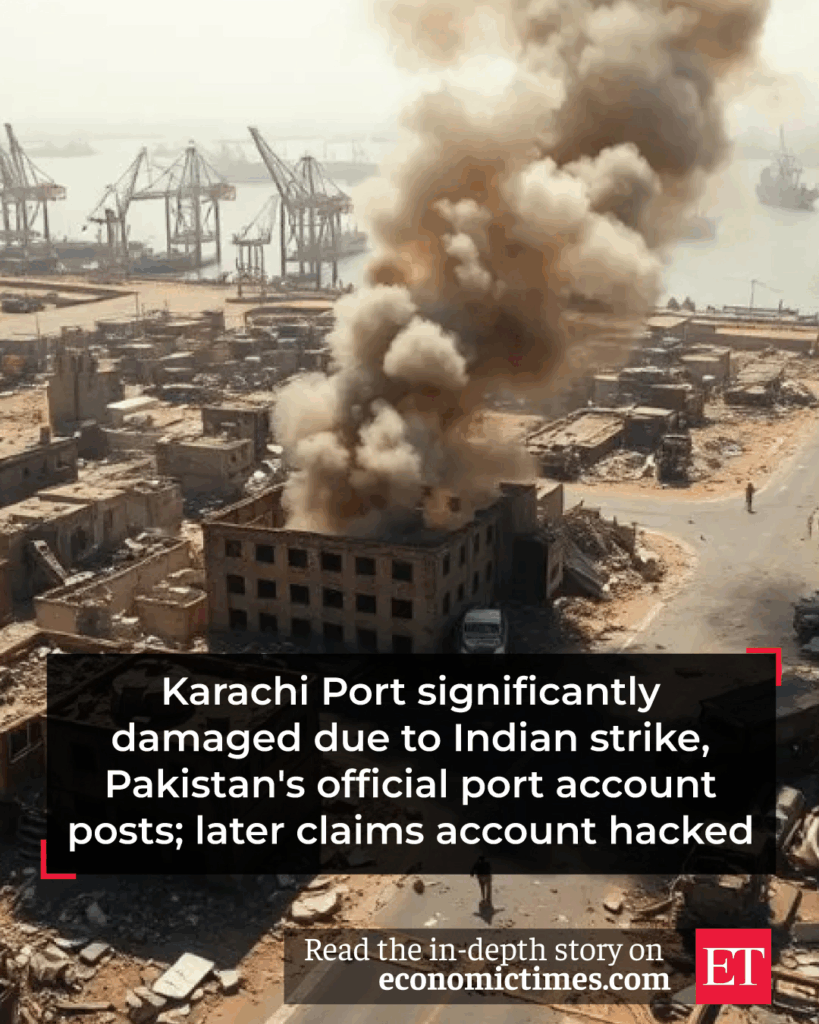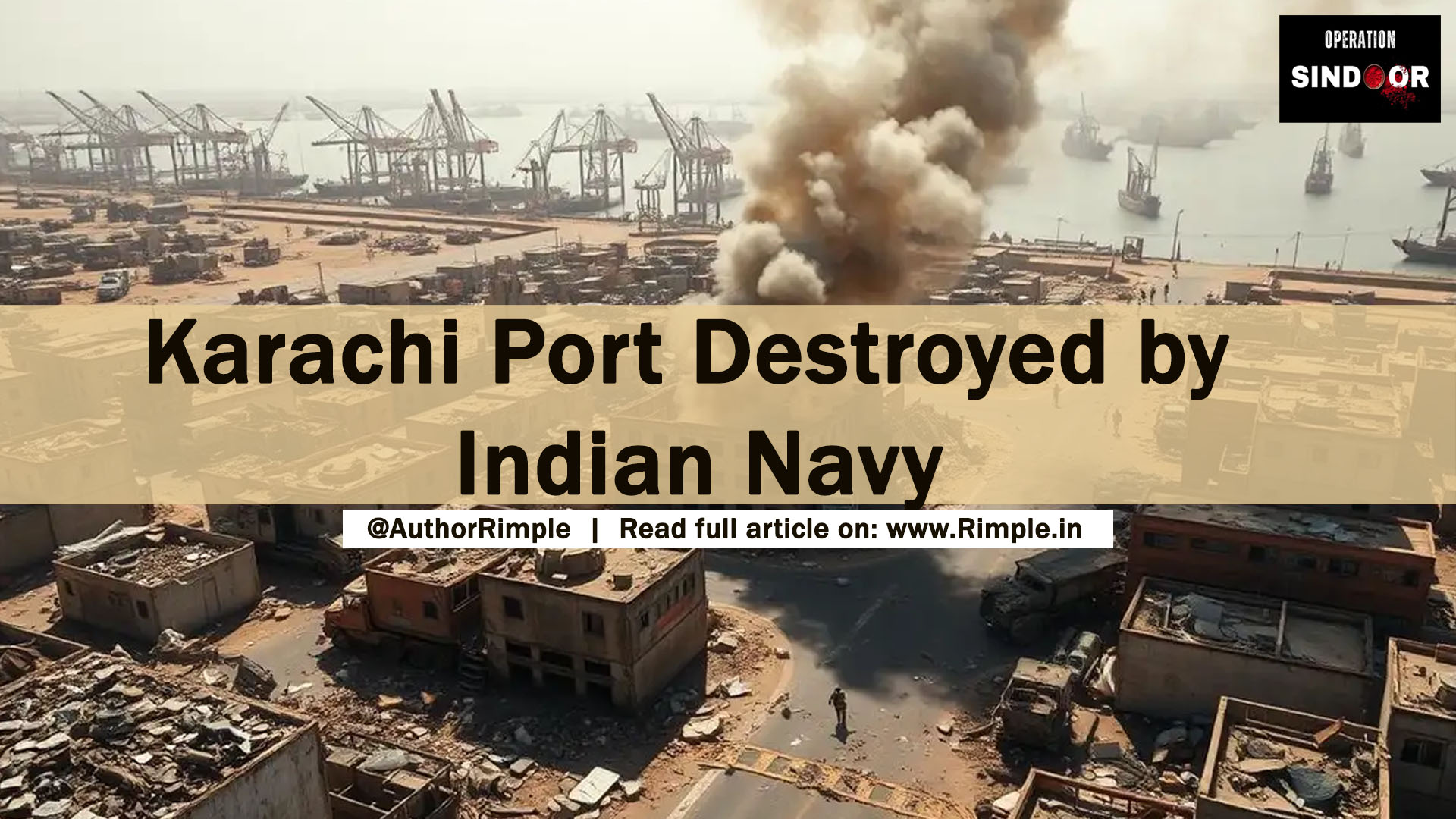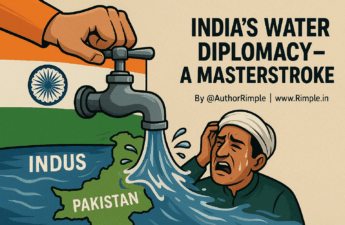Buckle up, folks! The Indian Navy just pulled off a jaw-dropping move that’s got Pakistan scrambling like a cat on a hot tin roof. On May 9, 2025, India’s mighty naval forces, led by the colossal INS Vikrant, unleashed a barrage of missiles on Karachi Port, Pakistan’s economic lifeline. This wasn’t just a slap on the wrist—it was a full-on knockout punch that’s left Pakistan’s coastline in chaos. Let’s break it down in simple terms, celebrate India’s strength, and have a little fun poking at Pakistan’s predicament.
Why Did India Strike Karachi Port?
This all started with Pakistan’s sneaky antics. On April 22, 2025, a horrific terror attack in Pahalgam, Jammu and Kashmir, killed 26 innocent Indian civilians. India pointed the finger at Pakistan-sponsored terrorists from The Resistance Front, a puppet of the notorious Lashkar-e-Taiba. Pakistan’s been playing this dirty game for years, but India’s had enough. After weeks of flexing muscles in the Arabian Sea, the Indian Navy decided it was time to teach Pakistan a lesson they won’t forget.
Indian Navy’s Prep in the Arabian Sea
The Indian Navy wasn’t just twiddling its thumbs before this strike. Since the Pahalgam attack, they’ve been out in the Arabian Sea, sharpening their claws. From April 30 to May 3, Indian warships, including Kolkata-class destroyers and advanced frigates, were conducting anti-ship missile tests and firing drills off the Gujarat coast, just 85 nautical miles from Pakistan’s drill zones. INS Vikrant, India’s pride and joy, was deployed in the Arabian Sea, ready to pounce. These weren’t just routine exercises—India was sending a loud message: “We’re locked and loaded!”
By May 8, Indian naval assets armed with the supersonic BrahMos missile moved closer to Karachi, about 600 nautical miles from Mumbai. The Western Naval Command in Mumbai had its entire fleet on high alert, with destroyers like INS Visakhapatnam and the aircraft carrier INS Vikrant leading the charge. For weeks, India’s navy was like a tiger stalking its prey, waiting for the right moment to strike.
The Big Blast at Karachi Port
On May 9, 2025, the Indian Navy let loose a storm of missiles on Karachi Port and Ormara naval base. Reports say INS Vikrant fired multiple BrahMos and possibly Tomahawk-class missiles, turning Pakistan’s key maritime hubs into a fiery mess. Explosions rocked Karachi, with flames and thick smoke billowing across the port. Local sources reported panic in the streets as the port, which handles 60-70% of Pakistan’s trade, was heavily damaged. Ormara, another critical naval base, also took a beating, with massive fires reported.
The destruction was no small feat. Karachi Port isn’t just a dock—it’s Pakistan’s economic backbone, handling 80% of their oil imports and most of their cargo. The Indian Navy’s precision strikes crippled key infrastructure, likely destroying docks, warehouses, and naval assets. Unverified reports claim the port is “completely destroyed,” with major parts reduced to rubble. This isn’t just a military blow; it’s an economic gut-punch that could choke Pakistan’s fuel supply, trade routes, and military operations.
Impact on Pakistan: Economy in Shambles, Navy in Tears
Pakistan’s in deep trouble now. Karachi Port’s destruction means their economy is on life support. Without this port, Pakistan can’t import oil, medicines, or rations smoothly. Their tanks and war machines could grind to a halt without fuel. The panic along Pakistan’s coastline is palpable—residents are reportedly fleeing, and emergency services are overwhelmed. Pakistan’s navy, already a minnow compared to India’s shark, is now even weaker. With only four frigates, six outdated submarines, and a handful of missile boats, they’re no match for India’s 140-warship fleet, including two aircraft carriers.
Pakistan’s military is crying foul, claiming they intercepted some missiles, but let’s be real—those claims sound like a kid boasting about catching a whale with a fishing rod. Their air defense systems took a beating, with India reportedly destroying radars and other assets. Pakistan’s Prime Minister Shehbaz Sharif and military chief Asim Munir must be hiding under their desks, wondering how to spin this disaster. Their so-called “fierce response” has been nothing but hot air so far.
Pakistan’s Feeble Response
What did Pakistan do? Not much, honestly. They’ve been firing small arms across the Line of Control and tried launching missiles and drones at Indian cities like Jammu, Pathankot, and Jaisalmer. But India’s air defense systems, like the S-400, swatted those away like flies. Pakistan’s attempts to hit back have been a flop, with their drones and missiles intercepted left, right, and center. They even announced a curfew in major cities and a blackout in some areas, probably to hide their embarrassment.
Pakistan’s been begging for help from their “brother” Turkey, who sent a warship and some aircraft to Karachi. But let’s face it—Turkey’s corvette isn’t going to save Pakistan from India’s naval might. Pakistan’s also been spreading fake news, claiming they chased Indian Rafale jets or shot down quadcopters. Nice try, but the world’s not buying it.
India’s Navy: The Heroes of the Hour
The Indian Navy’s strike was a masterclass in strategy and power. INS Vikrant, India’s first home-built aircraft carrier, proved why it’s a game-changer. This floating fortress can launch combat aircraft and carry out precision strikes from the sea. Armed with BrahMos missiles, which can hit targets 900 km away with pinpoint accuracy, Vikrant and its destroyers turned Karachi into a cautionary tale. The Western Fleet, fully deployed from Mumbai, showed Pakistan that India’s ready to defend its borders and hit back hard.
This isn’t the first time India’s navy has humbled Pakistan. In 1971, during Operation Trident, Indian missile boats set Karachi Port ablaze, sinking Pakistani ships and burning oil refineries. History repeated itself in 2025, but with even more firepower. India’s three-domain strategy—land, air, and sea—is now a force to be reckoned with, and the navy’s just raised the bar.
Why Pakistan Deserves This Wake-Up Call
Let’s not sugarcoat it—Pakistan’s been asking for trouble. For decades, they’ve harbored terrorists, funded attacks on India, and played the victim when called out. The Pahalgam attack was the last straw. While India’s response was “measured and non-escalatory,” as Foreign Secretary Vikram Misri put it, it was also a clear message: mess with India, and you’ll pay a heavy price. Pakistan’s leaders, who thought they could hide behind their nuclear bluff, are now learning that India’s not afraid to hit where it hurts.
What’s Next?
The Indian Navy’s operation is ongoing, with warships still patrolling the Arabian Sea, keeping Pakistan on edge. International pressure is mounting on both sides to avoid further escalation, but India’s made its point loud and clear. Pakistan’s economy is reeling, their navy’s in tatters, and their morale is at rock bottom. Meanwhile, India stands tall, with its armed forces united and ready for any challenge.
For the average Indian, this is a moment of pride. Our navy, with its cutting-edge tech and fearless sailors, has shown the world what India’s capable of. So, let’s raise a cheer for the Indian Navy, the guardians of our seas, and give Pakistan a playful wave as they try to pick up the pieces. Better luck next time, neighbors—but maybe think twice before poking the Indian tiger again!
Note: Sources: Information compiled from reports by Business Today, India Today, DNA India, NewsX, and posts on X, reflecting the sentiment and events as of May 9, 2025.
Some images





Also Read





